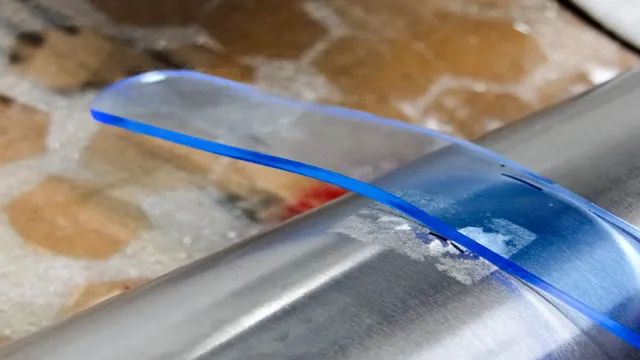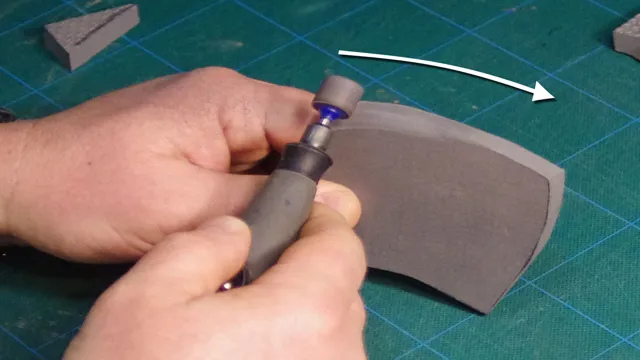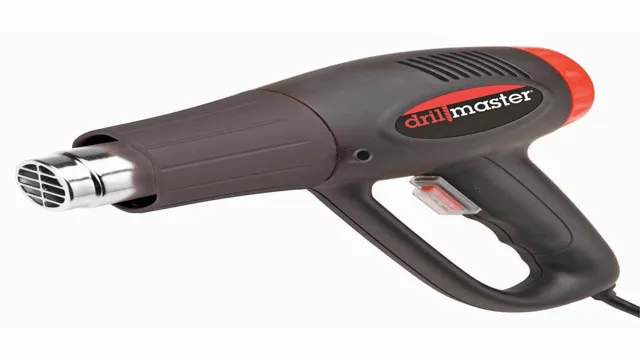
Have you ever wanted to create a unique, personalized piece of acrylic signage or display, but weren’t quite sure how to bend the material to your desired shape? Look no further! With just a heat gun, some patience, and a little bit of practice, you can easily bend and mold acrylic to your desired shape. Bending acrylic with a heat gun may seem intimidating at first, but it’s actually a simple process that just requires a bit of attention to detail. By heating the acrylic evenly and slowly, it becomes pliable and can be easily bent and manipulated into the shape you desire.
This is especially useful for creating custom signage, display cases, or even intricate pieces of art. Think of bending acrylic with a heat gun as akin to molding clay. Just as clay becomes malleable when warmed, so too does acrylic.
With a bit of practice, you can use a heat gun to create smooth curves, sharp angles, and any other shape you can imagine. Plus, because acrylic is a lightweight and durable material, your finished product will be both easy to handle and made to last. So why not give it a try? Whether you’re a seasoned DIYer or a newcomer to the world of crafting, bending acrylic with a heat gun is a fun and rewarding experience that can lead to some seriously impressive results.
So grab your heat gun and get ready to put your creative skills to the test!
Introduction
Bending acrylic can be a challenging task, but it can easily be done with the use of a heat gun. If you have never worked with a heat gun before, it can seem intimidating. But, with a little practice and the right technique, you can achieve great results.
Before you begin, it is important to have the right tools. You will need a heat gun, a clamp, a ruler, and a sheet of acrylic. The first step is to clamp the acrylic securely to a work surface.
Next, measure the section you want to bend and mark it with a pencil. Heat the area with the heat gun until it becomes pliable, then use a bending tool or your hands to shape it to the desired angle. Take your time and make sure to keep the heat gun moving to avoid melting the acrylic.
Once you are finished, let the acrylic cool down and your bends will become permanent. With practice, you’ll find that bending acrylic with a heat gun is an efficient and effective technique for creating custom shapes and designs.
What is Acrylic?
Acrylic is a versatile, man-made polymer that is widely used in a range of applications, from art and architecture to automotive and medical industries. It is a type of plastic that is formed by a chemical reaction between monomers, such as methyl methacrylate, that are mixed with a catalyst to create a liquid resin. This resin is then molded or cast into various shapes and sizes, depending on the intended use.
One of the unique features of acrylic is that it can be made into a variety of colors, textures, and finishes, making it a popular material choice for designers, artists, and engineers alike. Its durability, flexibility, and transparency also make it an ideal material for everything from windows and lenses to furniture and signage. So, whether you are creating a piece of artwork, designing a building facade, or constructing a medical device, acrylic is a material that offers limitless possibilities and potential.

Why Use a Heat Gun?
Heat Gun Introduction Are you tired of struggling to remove old paint, defrost pipes, or shrink wrap objects? If so, using a heat gun may be the perfect solution for you. A heat gun is a versatile tool that generates heat in a controlled manner, making it perfect for a variety of tasks. In this blog section, we will delve into the reasons why you should use a heat gun for your DIY projects or professional tasks.
We’ll explore the benefits, types, applications, and safety tips regarding the heat gun, so you can understand why it’s a must-have tool in your kit. So, let’s get started and find out more about the incredible heat gun!
Preparation
If you’re wondering how to bend acrylic with a heat gun, the first step to take is preparation. The acrylic sheet must be clean and free of any debris or oil, which can cause the material to bubble or crack when heated. To clean it, use a mild soap and water solution, then rinse and let it dry.
Next, decide on the shape you want to achieve and mark it with a felt-tip pen or masking tape. Remember that the thicker the material, the longer it will take to heat, so be patient and don’t rush the process. Also, keep in mind that the heat gun should be kept at a distance of at least six inches away from the acrylic to prevent overheating and scorching.
By properly preparing the acrylic and taking your time, you can successfully bend and shape it to your desired form with a heat gun.
Materials Needed
When it comes to preparing for a task, making sure you have all the materials you need is key. This also applies to starting a project, whether it’s building a birdhouse or baking a cake. To ensure your project is a success, you need to gather all the necessary materials beforehand.
This can range from tools like hammers or spatulas, to ingredients like wood or flour. Taking the time to prepare beforehand will save you from running to the store halfway through your project, and can prevent mistakes from happening due to missing tools or ingredients. So, before you start any project, make sure you have everything you need at your fingertips.
Happy crafting, building, and baking!
Acrylic Preparation
Acrylic Preparation When it comes to working with acrylic paint, preparation is key. Before you begin, it’s essential to make sure your surface is clean and primed. If you’re working on canvas, you’ll want to apply a layer of gesso to both sides and let it dry completely.
This will ensure that the paint adheres well to the surface and won’t flake or peel off over time. Next, you’ll want to consider your color palette. Acrylic paints are known for their versatility and can be used in many different ways.
You can mix your colors to create custom shades or use them straight from the tube for a bold, vibrant look. It’s essential to start with a basic palette of primary colors and then add in other colors as needed. Once you have your surface prepped and your colors selected, it’s time to get painting.
One important thing to keep in mind is that acrylic paint dries quickly, so you’ll need to work efficiently to blend your colors and create your desired effects. Don’t be afraid to experiment with different techniques and brush strokes to achieve the look you want. In summary, preparing your surface, selecting your colors, and experimenting with techniques are all essential steps in working with acrylic paint.
With a little practice and patience, you can create beautiful works of art that will last for years to come. So, grab your paints, get creative, and have fun!
Safety Precautions
As with any outdoor activity, preparation is key to ensuring a safe and enjoyable experience. Before embarking on a hike, it’s important to do some research on the trail you’ll be taking and the weather conditions you’re likely to encounter. Make sure you’re wearing appropriate clothing and footwear, and pack plenty of water and snacks to keep you fueled and hydrated.
It’s also a good idea to bring a first aid kit in case of any minor injuries, as well as a map and compass or GPS device to help you stay on track. By taking the time to prepare for your hike, you’ll be better equipped to handle any challenges that may arise along the way.
Bending Process
Bending acrylic can be a tricky process, but with the right tools and technique, it can be done easily. One of the best ways to bend acrylic is with a heat gun. To begin the process, first, you’ll want to clamp down the acrylic sheet tightly to prevent it from bouncing or moving during the bending process.
Next, you’ll want to place the heat gun about 1 to 2 inches away from the spot you want to bend and begin heating the area in a back-and-forth motion. It’s important to keep the heat moving to prevent the acrylic from overheating or burning. Once the acrylic begins to soften, use a bending jig or a piece of metal to shape the acrylic to your desired angle.
Hold the acrylic in place until it cools and hardens, and then remove the clamps. With a bit of patience and practice, you can achieve professional-looking bends in your acrylic using a heat gun.
Heating the Acrylic
“Heating the Acrylic” Bending Process In order to successfully bend acrylic, you need to apply heat to the material. This can be done through various methods such as using a heat gun or placing the acrylic in an oven. However, it’s important to note that acrylic can quickly become damaged if it’s heated too much or for too long.
To prevent this from happening, it’s recommended that you start with a lower temperature and gradually increase it until the acrylic becomes pliable. You should also avoid heating the same spot for too long, as this can cause discoloration or warping. Once the acrylic is heated and pliable, you can carefully bend it into the desired shape.
Just remember to be patient and take your time so that you don’t accidentally damage the material. By applying the right amount of heat and using proper bending techniques, you can create a beautiful and unique piece from acrylic.
Bending the Acrylic
Bending acrylic sheets can be a daunting task, but with the right technique and tools, you can easily create custom shapes and designs. The process of bending acrylic involves heating the sheet until it becomes pliable and then shaping it to the desired form. One popular method is using a strip heater, which evenly heats the acrylic along the length of the sheet to ensure a clean bend.
Once heated, the sheet can be bent by placing it over a curved surface or using a bend jig. It’s essential to work slowly and carefully, applying even pressure to avoid cracking or damaging the sheet. With patience and practice, mastering the art of acrylic bending can help you create stunning designs that stand out from the competition.
Cooling Down the Acrylic
When it comes to working with acrylic, one of the most common techniques used is bending. However, in order to properly bend acrylic, it needs to be cooled down first. This process involves heating the acrylic in a specific area until it becomes pliable, but then quickly cooling it down to maintain the desired shape.
The most effective way to accomplish this is by using a cool water bath or by using compressed air to blow cool air onto the heated area. It’s important to note that this process needs to be done carefully and slowly, as too much heat can cause the acrylic to warp or crack, while too little can cause it to break when bent. By carefully monitoring the temperature and cooling process, you can achieve perfectly bent acrylic pieces for your project.
Conclusion
Bending acrylic with a heat gun is a skill that requires patience and precision, but with a little practice, you’ll be able to shape this versatile material into almost any form you can imagine. Much like a sculptor working with clay, you’ll need to heat the acrylic slowly and evenly, ensuring that it reaches a pliable state without becoming too brittle or melting altogether. And just like any art form, the key to success is to stay focused on your vision, adjust as needed, and be willing to learn from your mistakes.
So grab your heat gun, put on some safety goggles, and get ready to bend it like Beckham–acrylic style!”
Tips and Tricks
Bending metal is a complex process that requires careful planning and a fair amount of skill. One of the main tips for successful bending is to ensure that all measurements and angles are precise before beginning the process. This can be done using specialized bending tools and equipment, as well as careful inspection and measurement of the metal being bent.
It is also important to use the appropriate level of force and pressure when bending, as applying too much force can cause the metal to become distorted or even break. In addition, it can be helpful to use a lubricant or bending fluid to help the metal bend smoothly and reduce the risk of damage. With practice and attention to detail, anyone can master the art of metal bending and create stunning and functional pieces that will stand the test of time.
So, remember to take your time, measure twice, and use the right tools and techniques for the job at hand.
Final Thoughts
When it comes to the bending process, it’s important to understand that there are a few factors that can affect the quality of the final product. One of the biggest things to consider is the material being used. Different materials will require different bending techniques, heating temperatures, and cooling methods.
It’s also important to consider the geometry of the part being bent, as this can impact the overall strength and durability of the final product. Additionally, the machinery being used for the bending process should be carefully selected and maintained to ensure proper functionality and accuracy. Ultimately, taking all of these factors into consideration can help to produce high-quality bent parts that meet industry standards and customer expectations.
FAQs
What type of heat gun should I use for bending acrylic?
When bending acrylic, it is best to use a heat gun with a variable temperature control and a narrow nozzle to concentrate the heat on the specific area you want to bend.
Can any type of acrylic be bent with a heat gun?
No, only cell cast acrylic can be bent with a heat gun. Extruded acrylic will not hold its shape when heated and cooled.
How long should I heat the acrylic with a heat gun before bending it?
The length of time you should heat the acrylic with a heat gun depends on the thickness of the acrylic. As a general rule, you should heat the acrylic for about 1 minute for every millimeter of thickness.
What is the best way to clamp the acrylic while it cools after bending?
The best way to clamp the acrylic while it cools is to use metal clamps, making sure to cushion the acrylic with soft padding to prevent scratching or damage to the surface.
Can I bend acrylic without a heat gun?
Yes, you can bend acrylic without a heat gun, but you will need to use a different method such as using a hot plate or a strip heater.
What safety precautions should I take when bending acrylic with a heat gun?
It is important to use protective gloves and eye goggles when bending acrylic with a heat gun. You should also work in a well-ventilated area and take care to avoid breathing any fumes.
What should I do if the acrylic cracks or breaks while bending?
If the acrylic cracks or breaks while bending, it is best to stop immediately and start over with a new piece of acrylic or seek professional help. Attempting to continue to bend or fix the broken piece can lead to further damage or injury.







